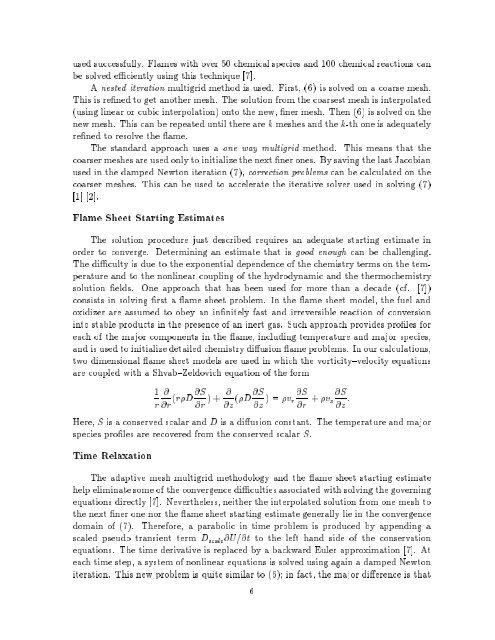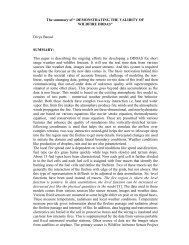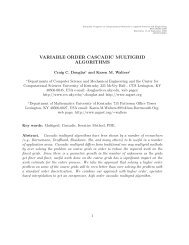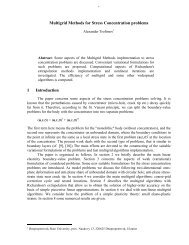numerical simulation of laminar diffusion flames problem ... - MGNet
numerical simulation of laminar diffusion flames problem ... - MGNet
numerical simulation of laminar diffusion flames problem ... - MGNet
You also want an ePaper? Increase the reach of your titles
YUMPU automatically turns print PDFs into web optimized ePapers that Google loves.
used successfully. Flames with over 50 chemical species and 100 chemical reactions canbe solved eciently using this technique [7].A nested iteration multigrid method is used. First, (6) is solved on a coarse mesh.This is rened to get another mesh. The solution from the coarsest mesh is interpolated(using linear or cubic interpolation) onto the new, ner mesh. Then (6) is solved on thenew mesh. This can be repeated until there are k meshes and the k-th one is adequatelyrened to resolve the ame.The standard approach uses a one way multigrid method. This means that thecoarser meshes are used only to initialize the next ner ones. By saving the last Jacobianused in the damped Newton iteration (7), correction <strong>problem</strong>s can be calculated on thecoarser meshes. This can be used to accelerate the iterative solver used in solving (7)[1] [2].Flame Sheet Starting EstimatesThe solution procedure just described requires an adequate starting estimate inorder to converge. Determining an estimate that is good enough can be challenging.The diculty is due to the exponential dependence <strong>of</strong> the chemistry terms on the temperatureand to the nonlinear coupling <strong>of</strong> the hydrodynamic and the thermochemistrysolution elds. One approach that has been used for more than a decade (cf. [7])consists in solving rst a ame sheet <strong>problem</strong>. In the ame sheet model, the fuel andoxidizer are assumed to obey an innitely fast and irreversible reaction <strong>of</strong> conversioninto stable products in the presence <strong>of</strong> an inert gas. Such approach provides proles foreach <strong>of</strong> the major components in the ame, including temperature and major species,and is used to initialize detailed chemistry diusion ame <strong>problem</strong>s. In our calculations,two dimensional ame sheet models are used in which the vorticity{velocity equationsare coupled with a Shvab{Zeldovich equation <strong>of</strong> the form1r@@r (rD@S @r )+ @@z@S(D@z )=v @Sr@r + v @Sz@z :Here, S is a conserved scalar and D is a diusion constant. The temperature and majorspecies proles are recovered from the conserved scalar S.Time RelaxationThe adaptive mesh multigrid methodology and the ame sheet starting estimatehelp eliminate some <strong>of</strong> the convergence diculties associated with solving the governingequations directly [7]. Nevertheless, neither the interpolated solution from one mesh tothe next ner one nor the ame sheet starting estimate generally lie in the convergencedomain <strong>of</strong> (7). Therefore, a parabolic in time <strong>problem</strong> is produced by appending ascaled pseudo transient term D scale @U=@t to the left hand side <strong>of</strong> the conservationequations. The time derivative is replaced by a backward Euler approximation [7]. Ateach time step, a system <strong>of</strong> nonlinear equations is solved using again a damped Newtoniteration. This new <strong>problem</strong> is quite similar to (6); in fact, the major dierence is that6












